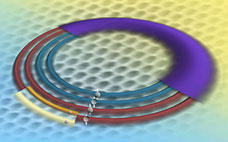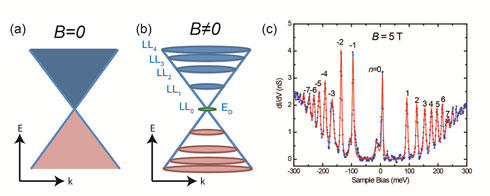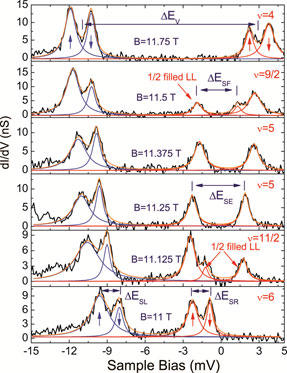Summary
The electrons in graphene are confined to the two-dimensional atomic layer of carbon atoms that make up the material . Since graphene was first extracted from graphite in 2004, there has been intense research as scientists rush to characterize the strange quantum properties of this extraordinary two-dimensional electron system. Graphene's exotic behavior presents exciting prospects for future technologies ranging from high speed electronics to touch screen displays. One of graphene's unique properties is that electrons move through the material at high speed and with little effort. Another manifestation of the material's unusual quantum properties is how the electrons move when put in a magnetic field. In ordinary materials, electrons in a magnetic field move in circular orbits with equally spaced energy levels as the orbit radii increases. In graphene, the energy levels are unequally spaced. These large energy spacings could potentially be used for a new quantum resistance standard. The goal of this project is to advance graphene-based technologies by designing direct measurements of graphene's electron energy spectrum in magnetic fields to gain an understanding of how electrons travel in this material and how they interact with defects and with other electrons.
Description

The energy spectrum of graphene's charge carriers is very different from ordinary metals and semiconductors. The conduction and valance bands meet at conical points, where the carriers have an energy that is linear in momentum, giving rise to a zero effective mass [Fig.1(a)]. This dispersion is called the Dirac cone because the equation describing the motion of the carriers resembles the Dirac equation for relativistic particles. At the conical point, called the Dirac point, the density of carriers is zero in an ideal graphene lattice (a property not found in real devices ). When a magnetic field is applied perpendicular to the graphene sheet, the charge carriers undergo cyclotron motion and condense into sharp quantized energy levels, called Landau levels [Fig. 1(b)]. A hallmark of graphene that results from the unique linear dispersion is that the energy spacing between the Landau levels is not constant but varies with energy, and a special state comes into existence at the Dirac point, where there were no carriers when the magnetic field was not applied. The cyclotron motion of the carriers can be used in scattering experiments to investigate how electrons travel in graphene and interact with defects, the lattice, and other charge carriers. This information is essential to fully exploit graphene for future device applications.

This project is developing methods to measure the energy spectrum of graphene's charge carriers in applied magnetic fields, and determine the fundamental interactions among graphene's charge carriers with defects, lattice structure, multilayer effects, and many-body interactions. Since graphene is an exposed two-dimensional electron system, every atom is a surface atom that can be probed directly using modern scanned probe microscopy techniques. This accessibility is in contrast to traditional two-dimensional electron systems, which are buried below the surface in semiconductor heterostructures. At the CNST we have developed unique scanning probe microscopy systems that operate in high magnetic fields and at cryogenic temperatures, enabling very high energy resolution spectroscopy. An international team of researchers have determined new and novel information from applying these measurement instruments to the graphene electron system. The research team, led by Joseph Stroscio, includes collaborators from NIST, the University of Maryland, Seoul National University, the Georgia Institute of Technology, and the University of Texas at Austin
The research team, using the specialized CNST scanning probe instruments, have directly determined how the graphene electrons quantize in an applied magnetic field [Fig. 1(c)]. The measurements also indicated that layers of graphene grown on a substrate of silicon-carbide behave as individual, isolated, two-dimensional sheets. On the basis of these results, the researchers suggest that graphene layers are uncoupled from adjacent layers because they stack in different rotational orientations, which give rise to observed moiré patterns. The electron orbits can also interact with the lattice stacking in the moiré patterns, creating energy gaps that affect how electron waves move through the multilayer material. These energy gaps could have implications for the design of certain graphene-based electronic devices.
Graphene's electrons possess additional symmetries which lead to a four-fold quartet structure of the electron states in a magnetic field. Theorists have predicted that this quartet of levels would split into different energies when immersed in a magnetic field, but until recently there had not been an instrument sensitive enough to directly resolve these differences. By developing a new SPM instrument that operates at millikelvin temperatures, the research team for the first time could directly measure the electron density of all four states contributing to a single Landau level (Fig. 2). By tuning the magnetic field, the research team could also tune the electron-electron interactions in graphene, which were observed directly in the change in the energy separations between the various sub-levels in the spectra in Fig. 2 as different levels passed through the Fermi energy at 0 V. Quite unexpectedly, new many-body quantum states were observed at half-filling factors where a single Landau levels splits in "half". One possible explanation for this behavior is that the electrons formed a "condensate" between neighboring graphene sheets in which they cease moving independently of one another and act as a single coordinated unit. If this hypothesis proves to be correct, it could point the way to the creation of new quantum graphene devices based on quantum condensates that are highly energy efficient operating with very-low-heat production.

News
Graphene Yields Secrets to Its Extraordinary Properties
Electron Transport: Study of Electron Orbits in Multilayer Graphene Finds Unexpected Energy Gaps
NIST Researchers Hear Puzzling New Physics from Graphene Quartet's Quantum Harmonies
Selected Publications
- Observing the quantization of zero mass carriers in graphene, D. L. Miller, K. D. Kubista, G. M. Rutter, M. Ruan, W. A. deHeer, P. N. First, and J. A. Stroscio, Science 324, 924-927 (2009).
NIST Publication Database Journal Web Site - Real-space mapping of magnetically quantized graphene states, D. L. Miller, K. D. Kubista, G. M. Rutter, M. Ruan, W. A. deHeer, M. Kindermann, P. N. First, and J. A. Stroscio, Nature Physics 6, 811-817 (2010).
NIST Publication Database Journal Web Site - High-resolution tunnelling spectroscopy of a graphene quartet, Y. J. Song, A. F. Otte, Y. Kuk, Y. Hu, D. B. Torrance, P. N. First, W. A. deHeer, H. Min, S. Adam, M. D. Stiles, A. H. MacDonald, and J. A. Stroscio, Nature 467, 185-189 (2010).
NIST Publication Database Journal Web Site Epitaxial graphenes on silicon carbide, P. N. First, W. A. deHeer, T. Seyller, C. Berger, J. A. Stroscio, and J. Moon, Materials Research Bulletin 35, 296-305 (2010).
NIST Publication Database Journal Web SiteMore

